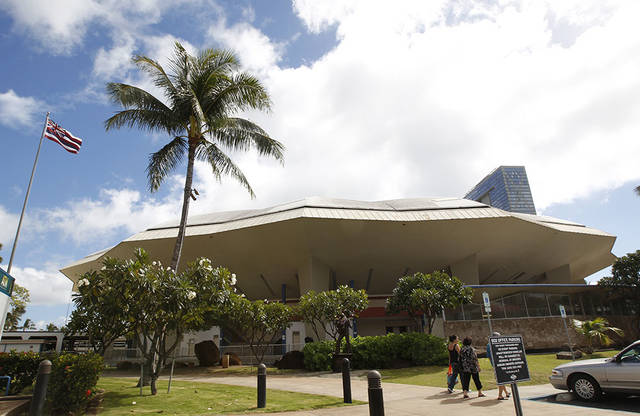The history of the Neal Blaisdell Center incorporates a theme familiar to Honolulu residents. In addition to its functions as a cultural and convention center, it was conceived as a war memorial. Like other such memorials — the Natatorium topping this particular list — it’s fallen into disrepair, though conditions are nowhere as bad as at the crumbling Waikiki pool. Still, there’s little agreement about the approach to renovation.
Few would argue against freshening up the Blaisdell complex, so it better serves residents and tourists. But the question is one of scale: How much is enough?
The suspicion is that the latest plan put forward by Mayor Kirk Caldwell is too much, at least for the foreseeable future.
In unveiling the draft environmental assessment document detailing the plan, Caldwell said a private partner is being sought to help shoulder the cost of the redevelopment and would operate the complex in exchange for fronting some construction help.
There’s nothing wrong with that ideal, but the bottom line is still a jaw-dropping price tag. When the Blaisdell project’s master plan was released in March, the estimate was $716.8 million, but now, only nine months later, it’s risen to $773 million.
Rising cost projections comprise much of the public anxiety over the city’s troubled rail project. So taxpayers are reasonable to fear that too much of that burden will land on them, even with a fairly attractive public-private partnership.
Further, that development model, known in shorthand as a “P3” project, is now proposed but as yet unproven for rail. The mere hope for a development partner is not enough to take to the bank.
It’s worth having the public discussion — comments on the plan are being taken through Dec. 10. But assuming much of the cost falls to the cash-strapped city, already blanching at the thought of finishing rail, now seems a bad time for committing to anything like what’s outlined in the document.
For example:
>> In the concert hall, the city proposes adding a new multipurpose venue, expanding the lobby to provide an air-conditioned space for pre-functions, renovating the bathrooms and building a new roof terrace.
>> In the exhibition hall, the plan is for developing new hall and parking structures with 500 more parking spaces, covered terraced areas, storage, water features and open space.
>> In the arena, the vision is for enclosing the facade of the structure in glass, adding a new cafe and box office, extending Victoria Street along with Complete Streets elements along Kapiolani Boulevard and offering centralized plazas and open space.
Surely there are “nice to haves” mixed in there with the “need to haves,” and that’s what’s driving up the costs so radically.
It’s good that the mayor has a vision for a coordinated arts, entertainment and meetings campus, linking the city-owned Thomas Square and Blaisdell complex. The adjacent location of the private nonprofit Honolulu Museum of Art is complementary to that vision.
However, even the mayor, cognizant of how the cost projections are being received, acknowledges the possibility of scaling back some of the features, at least initially.
That would be wise, as would be re-examining some of the development choices in the context of energy efficiency, which is a big concern these days.
Does providing larger air-conditioned spaces seem sensible, or even desirable, for a city like Honolulu? Part of Hawaii’s attraction is supposed to be its easy indoor-outdoor lifestyle. If evenings invite people to gather outside, a design for more open air, rather than less, would be appropriate for gathering spaces.
The Blaisdell certainly requires upgrades and redesign to improve its capabilities and enhance the audience experience. That is where the investment should be. The city should proceed carefully, avoiding a leap into costs that won’t be balanced by real benefits to the public.

